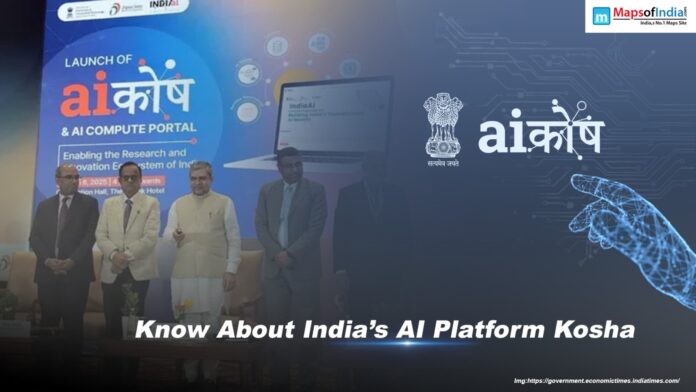AI Kosha is made to provide researchers and companies access to datasets so they may create AI tools like large language models (LLMs) and more. One of the seven main pillars of the India AI Mission is the India AI Datasets Platform, of which AI Kosha is a crucial component. Supported by a ₹10,370 crore budget, this program is the government’s main effort to advance AI research and its use across many industries. The Compute Capacity pillar was recently introduced as part of this endeavour, enabling academic institutions and startups to share access to potent Graphics Processing Units (GPUs) required for AI model training.
In addition to launching several other initiatives targeted at expanding access to AI, Union IT Minister Ashwini Vaishnaw last week marked the one-year anniversary of the India AI Mission by launching the all-in-one dataset platform AI Kosha. One of the seven pillars of the Rs 10,370 crore India AI Mission, the dataset platform seeks to offer a single gateway for easy access to tools, datasets, and AI models.
What is AI Kosha?
According to the Ministry of Electronics & IT, AI Kosha, also known as the India AI Datasets Platform (IDP), is a platform that will provide Indian academics, entrepreneurs, and startups access to computing power, datasets, tools, and a safe sandbox environment so they can create cutting-edge AI applications and solutions. The IDP is a repository for various models, datasets, and examples that promote AI innovation. Additionally, it offers lectures and tools in an AI sandbox, a programming environment. AI enthusiasts, academics, and makers may all benefit from this platform. To assist users in determining if the data is appropriate for their AI projects, it offers various datasets, each with an AI Readiness Score.
Currently, the AI Kosha has 80 models and around 300 datasets. It seeks to increase access to models and datasets from various sectors and sources to spur AI-based research and innovation, share Toolkits to facilitate the development of AI solutions, and showcase use cases to generate ideas for applications that can be developed with the platform’s resources.
During the event, Ashwini Vaishnaw, the Union Minister for Electronics and Information Technology, discussed the growth of GPU resources. According to him, the government has raised the number of GPUs available for shared access from 10,000 to 14,000, as was previously indicated this year. The dataset collection will continue to grow in the future. The Ministry of Electronics and Information Technology (MeitY) Secretary S Krishnan underlined that access to these datasets will allow companies and researchers to create India-specific AI models, addressing issues such as AI bias. The government has also created the AI Compute Portal, with Krishnan stating that 15,000 GPUs will be made accessible initially.
“The AI compute element is the largest part of the mission, with nearly 45% of the total funding allocated to the compute pillar,” Krishnan stated. The government is coordinating with GPU contributors to integrate API linkages to enable flawless connections between service providers and the portal.
In addition to AI Kosha, the government is working on a basic AI model made indigenously. The worldwide advancement in artificial intelligence, mainly the arrival of low-cost fundamental models from competing countries, has hastened this effort. The initiative aims to make India a global leader in artificial intelligence by encouraging the development of domestic technical talents. In order to induce innovation, the Indian government is a big promoter of open data. More than 12,000 databases from different government departments are already accessible on the Open Governance Data (OGD) portal (data.gov.in). By proceeding with this strategy, AI Kosha desires to increase access to structured data to help researchers, entrepreneurs, and policymakers evolve AI solutions that will fulfil the social and economic demands of the country.
A year after its debut, Vaishnaw also presented AI Kosha, the India AI Datasets Platform, and several projects under the ₹10,000 crore India AI Mission, marking an important milestone. According to him, 22 of the 67 applications the government is now considering for an Indian fundamental model are huge language models. Vaishnaw stated that a sizable amount of the shared computing facility will be devoted to creating India’s foundation model. “We will add more GPUs every quarter,” he added. For us to begin working on it, I have instructed the team to pick out the truly mature apps and at least choose a few of them, perhaps three or five, so that we can start working on it.
Vaishnaw stated that non-personal data from several ministries and departments, including agriculture, weather forecasting, logistics, and datasets from Bhashini, the government portal for Indian language translation, are available on AI Kosha to facilitate model training. The government is collaborating with business firms to gather non-personal data for the platform.
The AI Competency Framework was launched to help civil servants develop their capacity, and iGOT AI within the iGOT Karmayogi government capacity-building platform to recommend courses tailored to civil servants’ roles. Additionally, 27 AI data labs are set up in tier-2 and tier-3 locations. According to Vaishnaw, India will have its own GPU chips in three to four years. The country will rank among the top five tech nations in deep tech, semiconductors, and artificial intelligence in five years.
Vaishnaw stated that we are unaffected by the US’s 50,000 GPU shipment restrictions to nations like India. “If you look at that $500 billion, it’s by a set of private investors, to be invested not just in the United States but across the world over several years, and not one rupee or not $1 of that is actually from the government,” Meity secretary S Krishnan said during the launch about the recent investments seen in the US. On the other hand, we have a very clear and targeted approach that outlines how to embrace artificial intelligence nationwide through seven distinct verticals that will support all necessary aspects.




